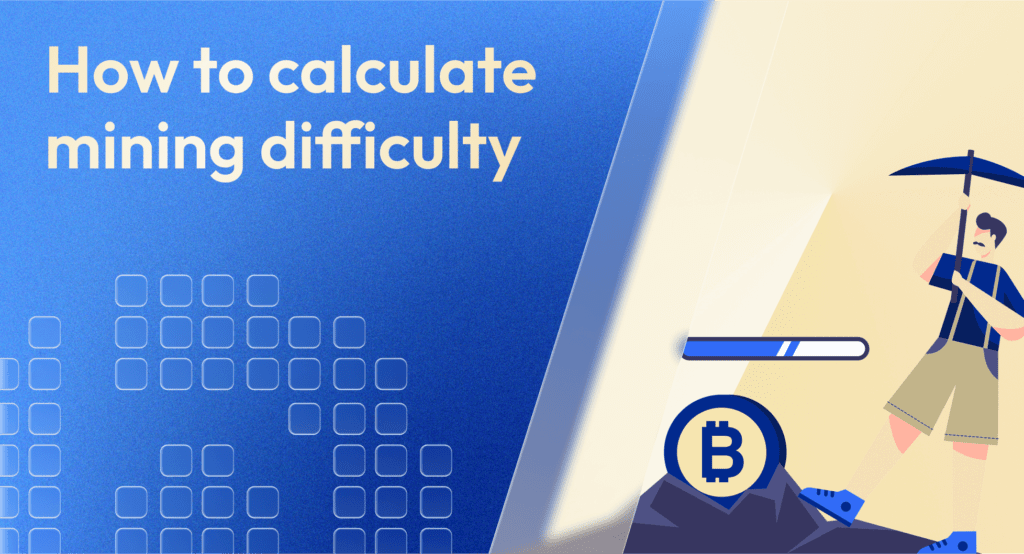The “proof-of-work” (PoW) algorithm is commonly used to calculate cryptocurrency mining difficulty. The exact algorithm employed differs for every cryptocurrency, but here you’ll get a broad explanation.
Miners compete in a PoW-based cryptocurrency network to solve challenging mathematical problems to add new blocks to the blockchain. These challenges necessitate a substantial amount of processing power to solve, and the difficulty of the task is modified regularly to maintain a consistent block time (the average time it takes to mine a new block).
The mining difficulty is modified to conform with a specified regulation established by the cryptocurrency system. The goal is to maintain a roughly consistent average block time regardless of changes in the overall network hash rate (the combined processing capability of all miners in the network).
The target value or difficulty target is the most commonly used way for estimating mining difficulty. This target number is the highest value that a valid block hash must be less than or equal to for the network to accept the block. A lower target value indicates greater difficulty.
Why Is Bitcoin Mining Difficulty Important?
You’ve definitely seen this term used in conversations about popular digital assets, but have you ever considered why it’s so significant? So, get ready to solve the enigma of Bitcoin mining difficulty.
Mining difficulty controls how difficult it is to find a new block on the blockchain. This difficulty level is adjusted roughly every two weeks, or after every 2,016 blocks are mined. The goal is to keep the block production time consistent at around 10 minutes. But why is this significant?
Let’s explore!
Network Security: The mining difficulty of Bitcoin plays a crucial influence on network security. The greater the difficulty in mining additional blocks, the more computational power is required. This difficulty level serves as a barrier to potential attackers who may attempt to influence the blockchain. The greater the difficulty, the more secure the network.
Control of Supply and Inflation: Another important reason why Bitcoin mining difficulty matters is its relationship to the currency’s supply and inflation. The mechanism of difficulty adjustment ensures that new Bitcoins are neither created too rapidly nor too slowly. Bitcoin maintains its preset inflation schedule by limiting the rate at which new blocks are added. This scarcity helps to maintain its value, making it an appealing investment for many.
Technology Breakthroughs: The difficulty of mining Bitcoin serves as a drive for innovation and technology breakthroughs. Miners require increasingly powerful hardware to compete as the difficulty grows. This ongoing drive for efficiency and optimization results in the development of more powerful mining rigs, pushing the limits of what is possible in the world of computers. So, in a way, the difficulty level builds progress and stimulates technological advances.
Mining Profitability: Mining difficulty has a direct impact on miners’ profitability. When the difficulty grows, it becomes more difficult to mine new Bitcoins, requiring miners to invest in better technology and consume more energy. On the other hand, when difficulty reduces, mining becomes easier, and mining profitability rises. Understanding the mining difficulty level is therefore critical for miners to make informed decisions and remain competitive.
How often is the difficulty of Bitcoin mining adjusted?
The difficulty of Bitcoin mining is modified typically every 2,016 blocks or every two weeks. This adjustment phase is intended to keep the average block time around 10 minutes.
The particular process for increasing the difficulty is based on the Bitcoin network’s total computational power or hash rate. If the hash rate increases, showing that more miners are actively mining, the difficulty is increased. In the opposite case, if the hash rate falls, the difficulty is reduced.
The shift is made using a method that compares the time required to mine the previous 2,016 blocks to the ideal block time of 10 minutes. The difficulty is increased if the actual time was shorter, indicating that blocks were mined too rapidly. The difficulty is reduced if the real duration was longer, indicating that blocks were mined too slowly.
This adjustment process contributes to the Bitcoin network’s stability and security by ensuring that blocks are produced at a relatively constant rate, even if total mining power changes.
How is mining difficulty calculated?
Bitcoin mining difficulty is calculated with various formulas. However, the most common one is:
Difficulty Level = Difficulty Target/Current Target.
Note that the Difficulty Target is a hexadecimal notation of the target hash whose mining difficulty is 1.
In contrast, the current target is the target hash of the most recent block of transactions. When the two values are divided, it yields a whole number which is the difficulty level of mining Bitcoin.
For instance, if the answer is 24 trillion, then a miner is expected to generate approximately 24 trillion hashes before he can find the winning hash. Of course, sometimes miners can get lucky and find it with significantly fewer guesses.
In short, mining difficulty is calculated based on the total hash rate of the network and aims to keep the block creation time close to the desired target of 10 minutes. This guarantees the Bitcoin network’s stability, security, and integrity.
Conclusion
To summarize, Bitcoin mining difficulty is critical to network security, managing Bitcoin supply and inflation, promoting technological breakthroughs, and influencing mining profitability. It is an essential component of the Bitcoin economy that assures the blockchain’s stability and reliability.
Now you’ll understand what people mean when they talk about Bitcoin mining difficulties. Remember that the world of cryptocurrencies is ever-changing, therefore keeping curious and informed is essential to understanding its enigmas.
Read more: Bitmine.tech


